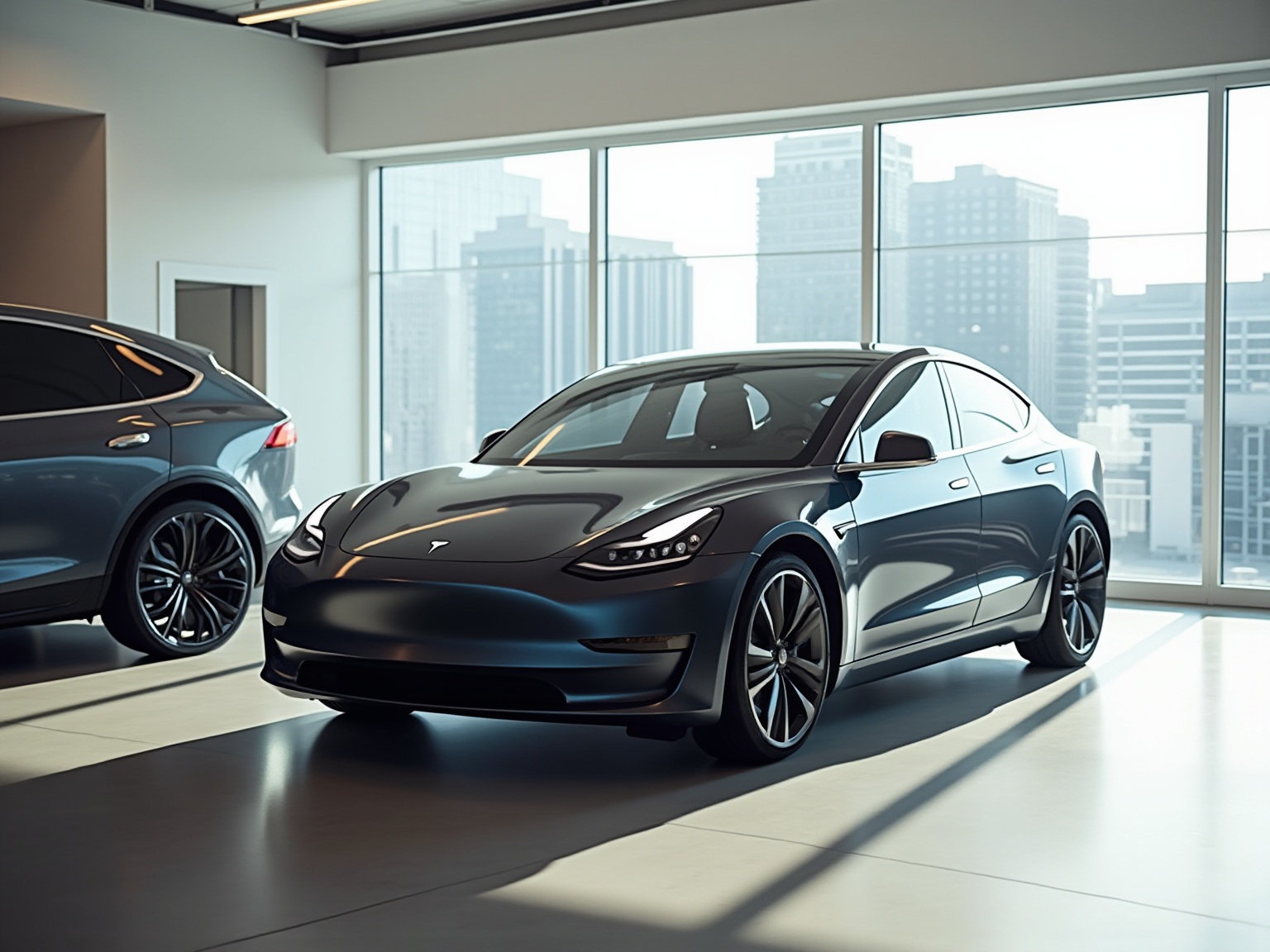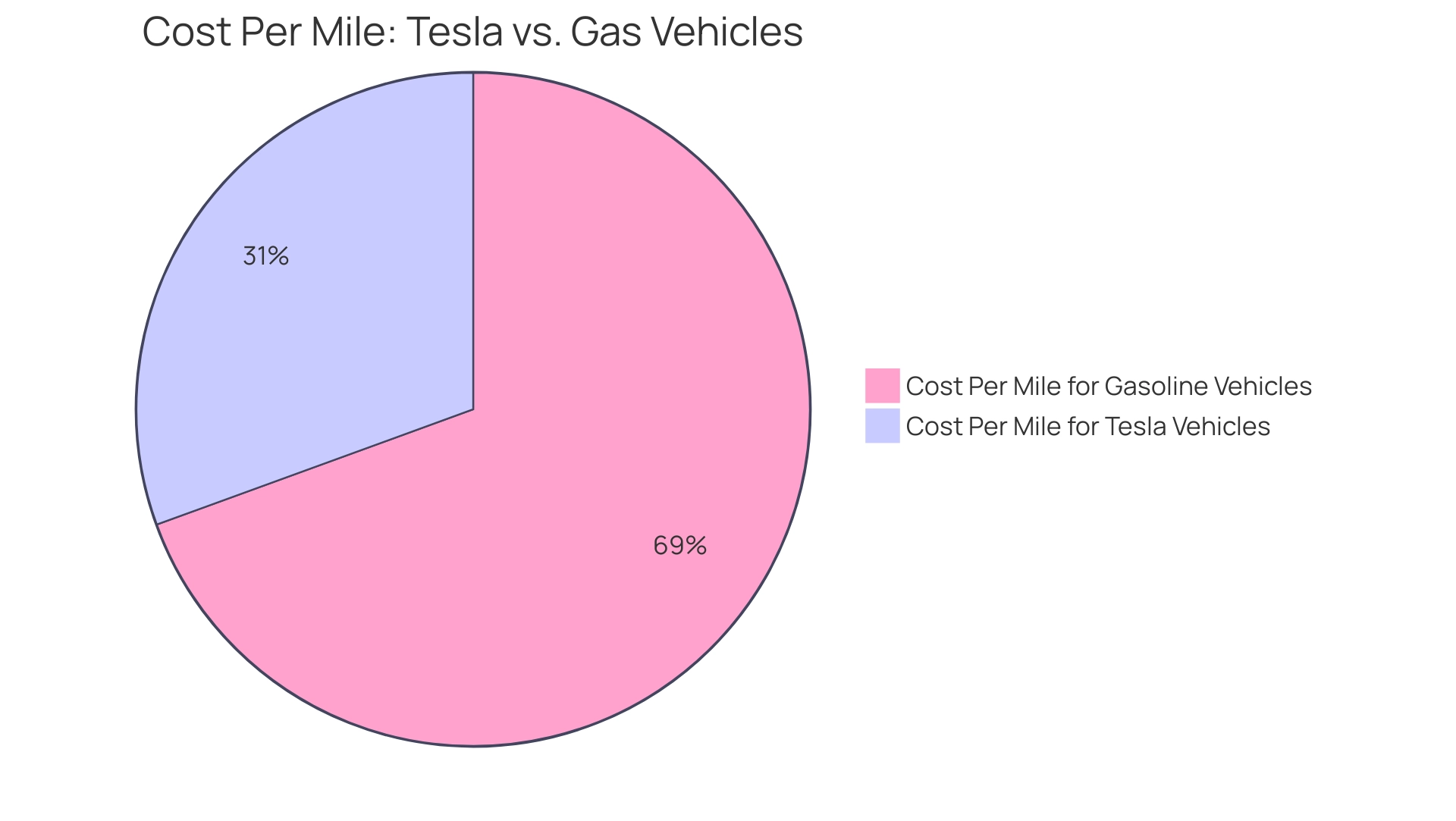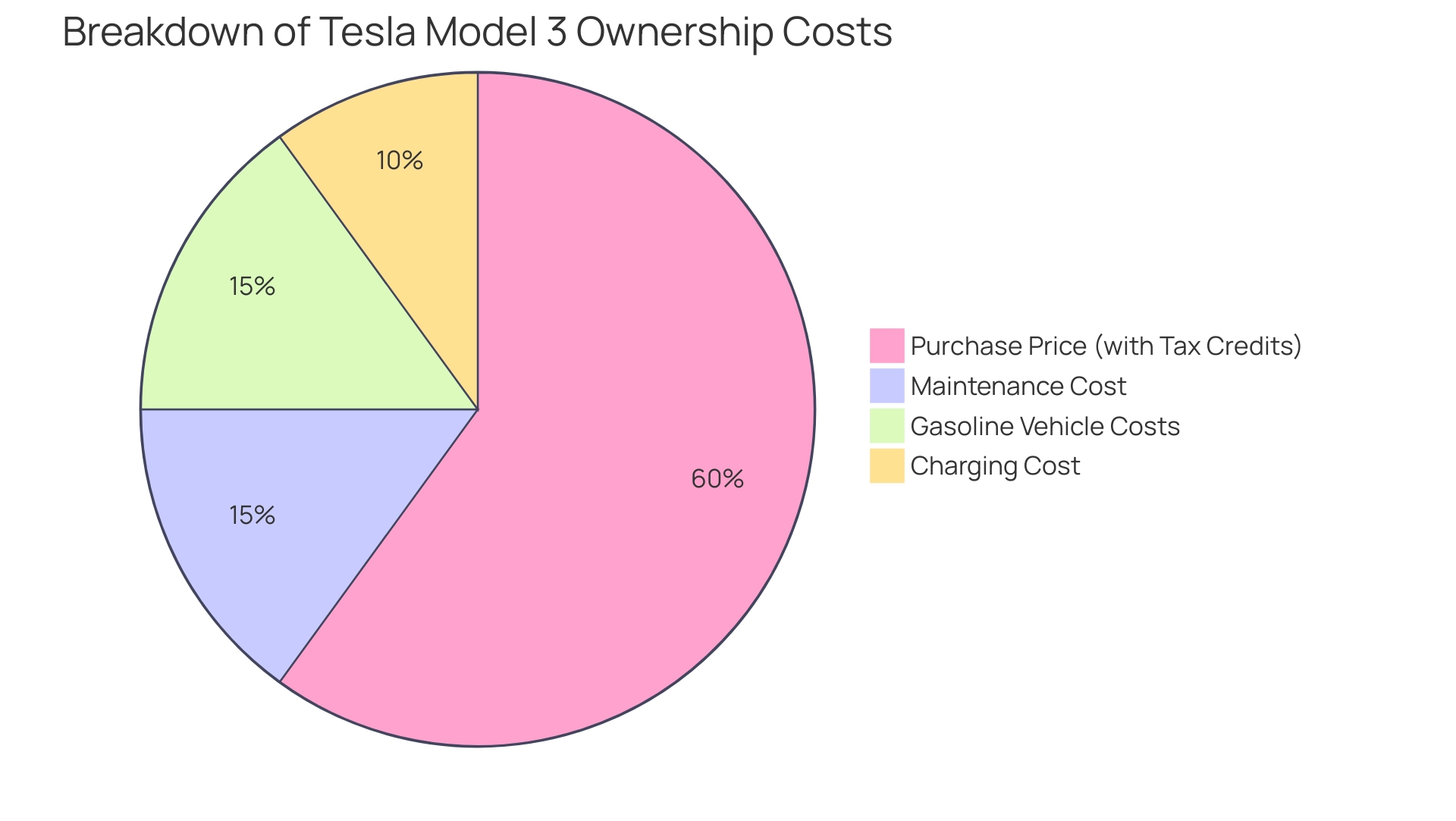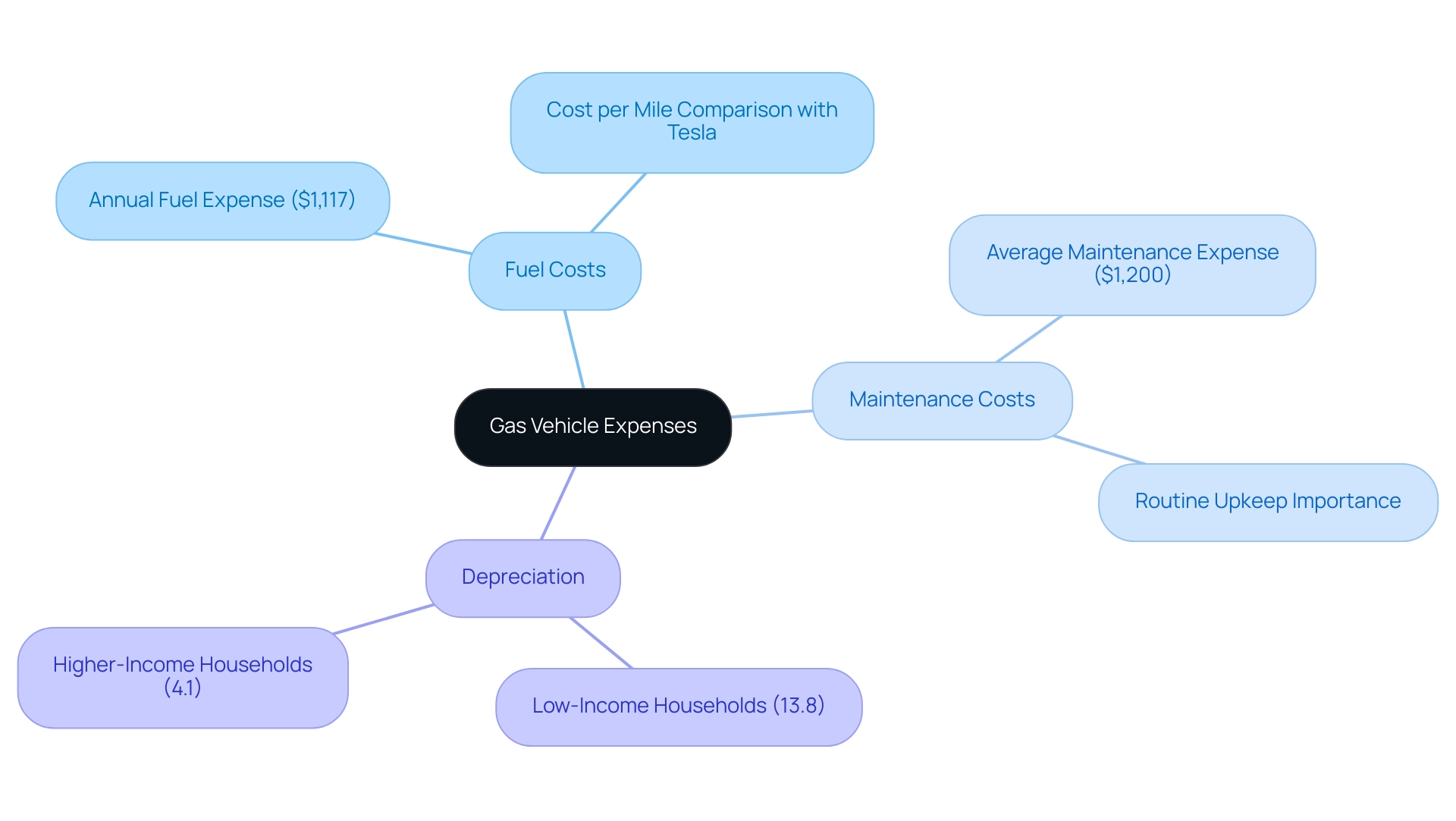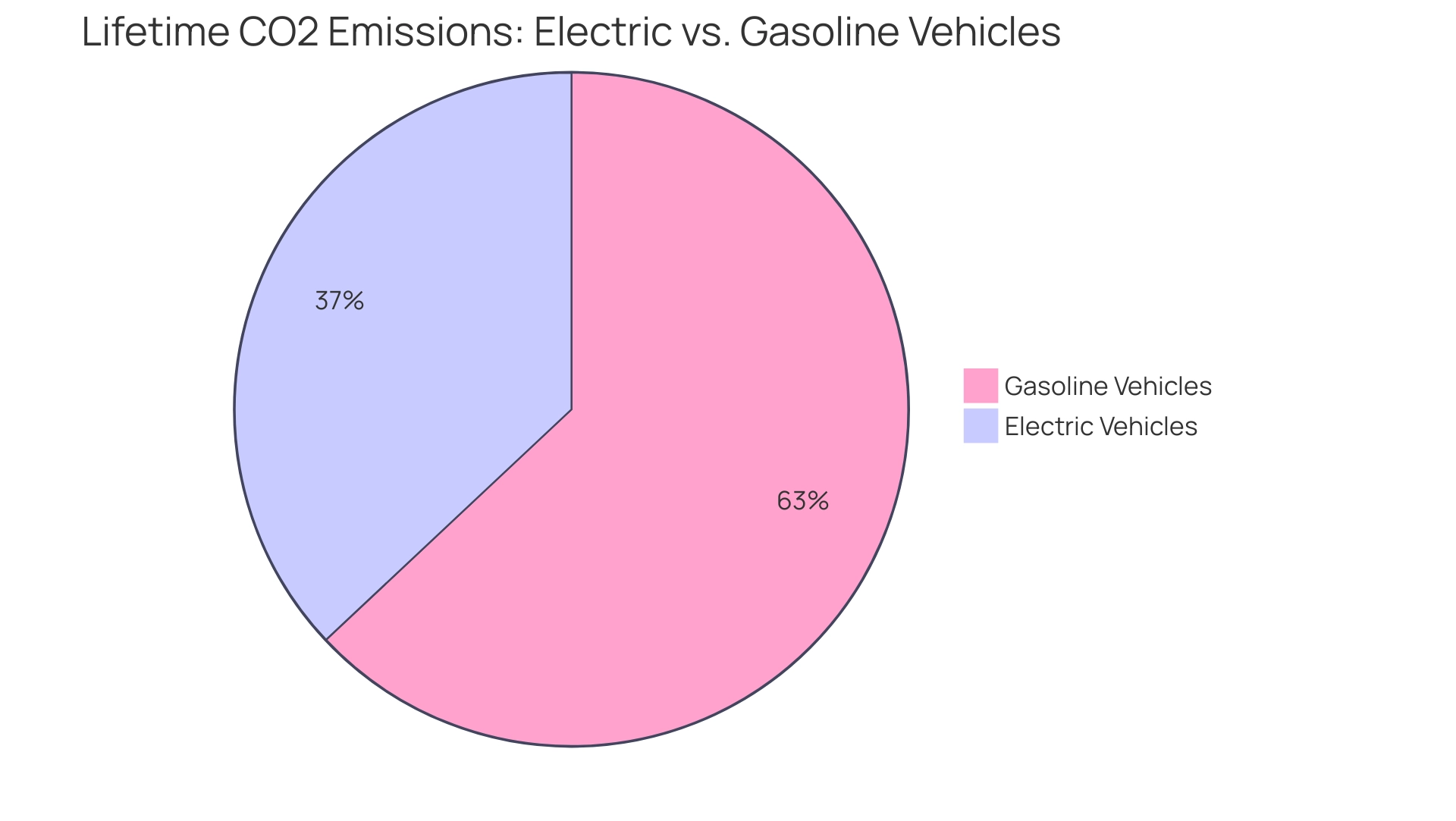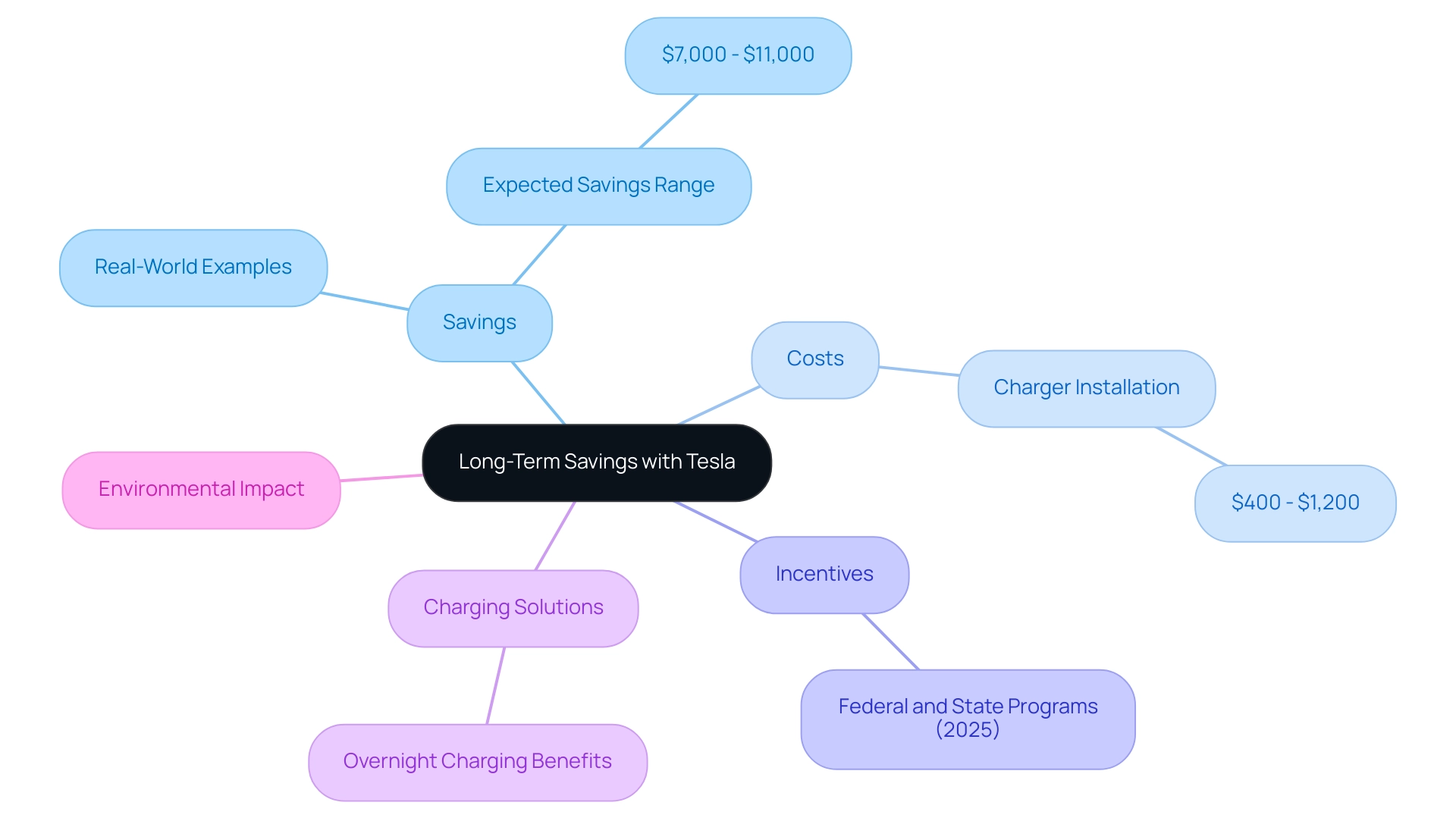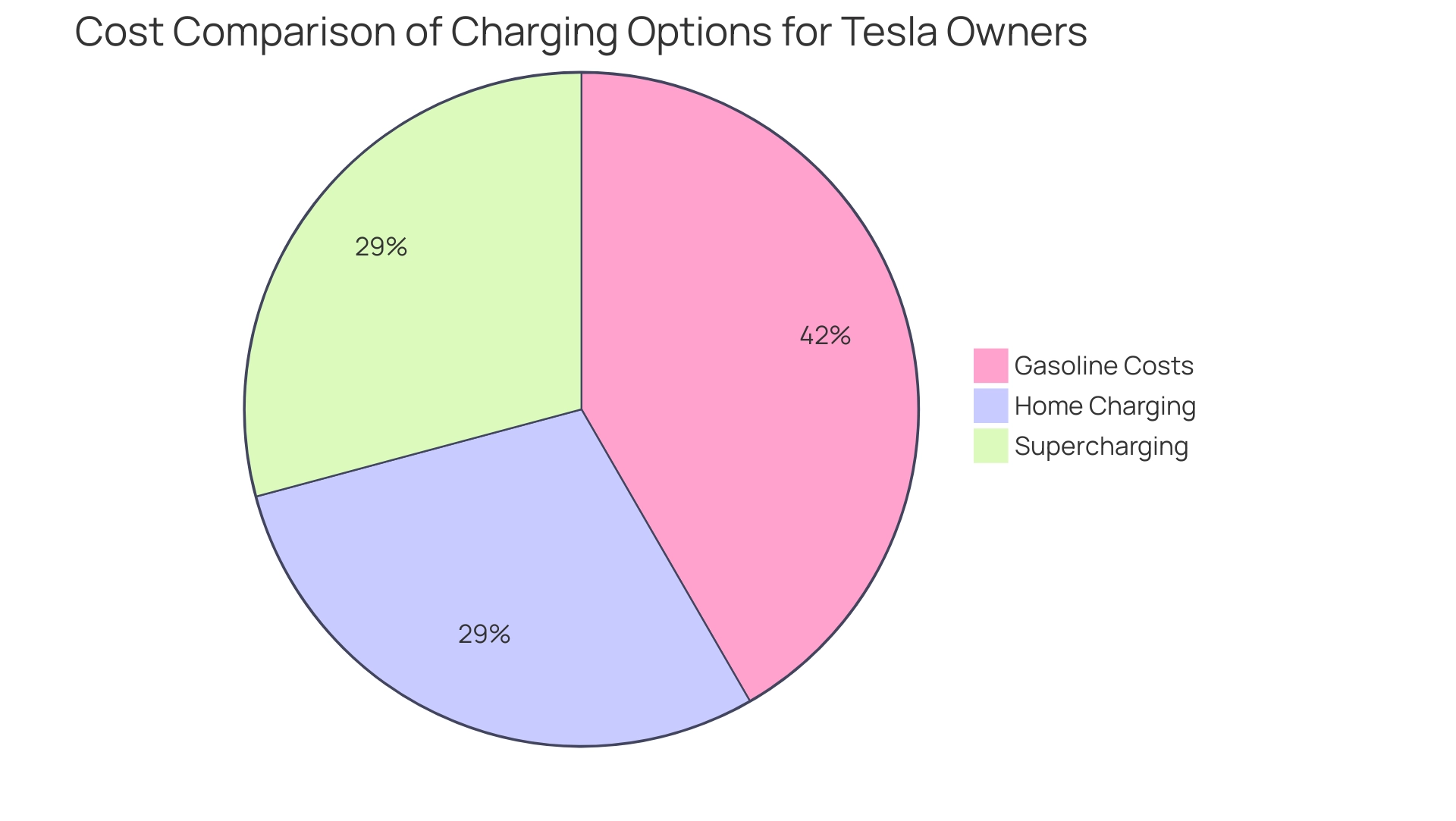Overview
We understand that managing energy costs can be a significant concern for many homeowners. The article thoughtfully compares the cost per mile of Tesla electric vehicles to traditional gasoline-powered cars, revealing that Tesla owners can enjoy substantial savings on operational expenses.
On average, they spend about 5 to 6 cents per mile, compared to 10 to 15 cents for gasoline vehicles. This analysis not only highlights the financial benefits but also emphasizes the long-term advantages of choosing electric vehicles, especially as fuel prices continue to rise and technology evolves.
By embracing electric vehicles, you can take a step towards energy independence while contributing positively to the environment. Together, we can navigate these changes and make informed choices that benefit both your wallet and our planet.
Introduction
In a world that increasingly values sustainability and cost efficiency, we understand that the debate between electric vehicles, especially Teslas, and traditional gasoline cars weighs heavily on many minds.
With fuel prices on the rise and environmental concerns becoming more pressing, it’s common to feel uncertain about the financial implications of vehicle ownership.
Electric vehicles not only promise lower operating costs but also offer a compelling solution for eco-conscious consumers eager to reduce their carbon footprint.
This article explores the various aspects of vehicle ownership, comparing the cost per mile, maintenance expenses, and environmental impacts of Teslas versus gasoline vehicles.
By examining these factors together, we hope to empower potential buyers to make informed choices that resonate with their financial goals and commitment to sustainability.
Understanding the Cost Per Mile: Tesla vs. Gas Vehicles
Assessing the cost per mile of Tesla versus gasoline is crucial for understanding the financial feasibility of owning a car. We understand that many homeowners are concerned about rising energy bills, and when comparing the cost per mile of Tesla versus gas, the average operating expense for Tesla vehicles is roughly 5 to 6 cents per mile. This figure can fluctuate based on electricity rates and driving conditions. In stark contrast, gasoline cars typically incur costs ranging from 10 to 15 cents per mile, heavily influenced by fluctuating fuel prices.
This notable difference highlights the potential savings linked to battery-powered cars. As gasoline costs continue to rise, evaluating the cost per mile of Tesla versus gas becomes increasingly important.
Furthermore, charging a Tesla at home often proves to be more cost-effective than refueling a gasoline-powered vehicle. This advantage becomes even more pronounced when considering long-term trends in pricing and the growing accessibility of renewable power sources. For example, battery-powered car owners can save between $790 to $1,310 for every 15,000 miles traveled compared to internal combustion engine (ICE) car owners. This shift to electric vehicles is not only environmentally friendly but also a financially wise decision.
Powercore Electric’s solar solutions can further enhance these savings by providing clean power for EV charging. Together, we can maximize expense efficiency while exploring solar options tailored for your needs.
Additionally, utilizing At Home Level 3 Chargers can significantly reduce charging times and improve the overall efficiency of owning an alternative mode of transport. These chargers are designed to offer quicker charging functionalities, making them an excellent option for homeowners aiming to enhance their transportation experience. Powercore Electric also provides a variety of resource-saving devices, including the Top 7 Power Saving Power Strips, which can assist in decreasing energy usage in households, further aiding in savings.
Practical examples demonstrate these savings as well. In 2025, the cost per mile of Tesla versus gas is expected to show that gasoline automobiles will have elevated expenses, while the cost per mile for battery-powered cars continues to decrease due to advancements in technology and efficiency. Expert insights consistently emphasize the financial feasibility of battery-powered transportation, reinforcing the idea that they are a wise investment for eco-aware homeowners looking to lower their utility expenses and improve their power autonomy.
Powercore Electric, with its strong community emphasis and internal team of specialists, is prepared to help you make this shift. Their dedication to transparency and customized service ensures that you receive the best possible guidance in navigating the transition to sustainable power solutions. By leveraging their expertise, you can optimize your installations and energy management, further enhancing the financial benefits of switching to electric transportation while considering the economic and environmental advantages of solar heating systems and energy efficiency integration, including available government programs and cleaning services.
Breaking Down Tesla Ownership Costs: Purchase, Maintenance, and Charging
Owning a Tesla Model 3 brings various expenses that go beyond just the initial purchase price. As we look toward 2025, the average cost of a Tesla Model 3 is around $39,990. However, potential federal tax credits of up to $7,500 can significantly reduce the effective price, making it an appealing choice for eco-conscious homeowners who care about their financial and environmental impact.
We understand that maintenance costs can be a concern. Tesla models are known for their cost-effectiveness, with the average yearly maintenance cost being about $500. This is a significant difference compared to the $1,200 typically spent on upkeep for gasoline cars. This contrast highlights the long-term savings associated with electric vehicle ownership, particularly when evaluating the cost per mile of Tesla versus gas.
Charging expenses are another crucial factor to consider. Charging a Tesla at home typically ranges from $10 to $18 for a full charge, resulting in a cost per mile of about 5 cents. In stark contrast, gasoline vehicles often face higher fuel costs, averaging around $3.77 per gallon, which can lead to yearly fuel costs ranging from $1,200 to $1,500, depending on driving habits.
These financial considerations illustrate the potential savings and advantages of owning a Tesla Model 3 compared to traditional gasoline cars. It’s clear that when we consider the cost per mile of Tesla versus gas, it becomes an attractive option for those looking to reduce their overall transportation expenses while embracing sustainable energy solutions.
Additionally, Powercore Electric Inc., a family-operated business dedicated to serving the California community for over 30 years, offers reliable power solutions that can enhance your Tesla ownership experience. Their in-house team of experts ensures high-quality installations and maintenance, including essential EV charging stations for Tesla owners. With a strong community focus and a commitment to transparency, Powercore Electric stands out as a trustworthy service provider for eco-conscious homeowners.
Their advanced solar solutions and expert support guarantee savings, making them an ideal partner for those eager to maximize their investment in sustainable energy. As noted by Forbes, the Tesla Model 3 is not only practical but also provides ample space for passengers and cargo, further enhancing its appeal as a sustainable choice. Together, we can work towards a more sustainable future.
Analyzing Gas Vehicle Expenses: Fuel, Maintenance, and More
Gas-powered automobiles can lead to mounting expenses over time, particularly when considering the cost per mile comparison between Tesla and gas vehicles. In 2025, the average fuel expense for a gas-powered automobile is expected to reach approximately $1,117 annually. This figure underscores the cost per mile comparison based on an average of 12,000 miles driven each year and a fuel price of around $3.77 per gallon. It’s essential to recognize this ongoing financial commitment required to keep a gas vehicle operational, especially when we reflect on the cost per mile between Tesla and gas options.
Maintenance costs for gas automobiles further contribute to the overall financial burden, averaging about $1,200 each year. This encompasses vital services such as regular oil changes, exhaust system repairs, and various mechanical services necessary for smooth operation. At Powercore Electric, our dedicated team of specialists ensures top-notch installations and maintenance for solar and electrical needs. This commitment aligns with the importance of routine upkeep for gas-powered vehicles to avoid unexpected expenses.
Moreover, gas-powered vehicles are susceptible to depreciation, significantly impacting their overall ownership costs over time. As fuel prices fluctuate, the financial strain of relying on gas-powered transportation can become more pronounced, particularly in regions where fuel costs are high. For instance, low-income households experience an average gasoline burden of 13.8%, in contrast to just 4.1% for higher-income households. This disparity highlights the uneven impact of fuel expenses across different economic groups.
To help mitigate these costs, adopting a gentle driving style, carpooling, and committing to regular maintenance can effectively reduce fuel bills. Real-world trends indicate that gas expenditures have changed over the decades, especially when evaluating the cost per mile between Tesla and gas vehicles, influenced by factors such as technological advancements and economic shifts. The early 2000s witnessed rising oil prices, while the 2010s focused on enhancing fuel efficiency, prompting a notable shift towards hybrid and electric transportation modes.
This transition, coupled with the emergence of rideshare services, has transformed consumer behavior regarding gas consumption, encouraging many to rethink the cost per mile comparison between Tesla and gas ownership. As Erinn Dimond wisely stated, ‘Roadside assistance gives you enough gas to make it to the nearest fueling station,’ a reminder of the ongoing challenges faced by gas vehicle owners.
Environmental Considerations: Tesla vs. Gas Vehicles
Electric automobiles, particularly models like Teslas, are increasingly recognized for their lower greenhouse gas emissions compared to traditional gasoline transports. We understand that many homeowners are concerned about energy bills and their environmental impact. Studies indicate that throughout their lifespan, plug-in cars can achieve a decrease in carbon emissions of up to 50%, even when considering the emissions created during power generation. This is especially significant given that the current carbon emissions associated with electricity range between 400 and 420 g/kWh, depending on various factors in the battery supply chain.
As the energy grid transitions to incorporate more renewable sources, the environmental benefits of battery-powered transportation are expected to become even more pronounced. It’s common to feel overwhelmed by the pollution caused by gasoline automobiles, which are responsible for substantial air pollution and greenhouse gas emissions throughout their operational lifespan, contributing to an estimated total lifetime CO2 emission of approximately 63 metric tons. In contrast, battery-powered modes of transport are linked to only 37 metric tons, highlighting the environmental advantages of making the transition.
Additionally, internal combustion engine (ICE) vehicles can produce up to 5.8 metric tons of emissions annually, further emphasizing the emissions disparity. Furthermore, battery-powered transportation generates no tailpipe emissions, which is a considerable benefit compared to gasoline cars. They are designed with rigorous safety standards that ensure they are as safe as, if not safer than, their gasoline counterparts. They undergo extensive testing and are equipped with advanced safety features, as demonstrated in the case study titled “Safety Standards for Electric Vehicles,” which illustrates the commitment to occupant safety in EV design.
Real-world instances demonstrate the significant effect of battery-powered modes of transport on reducing greenhouse gas emissions. As more homeowners embrace electric transport, the cumulative impact plays a major role in lowering total emissions, strengthening the argument for shifting to cleaner power options. Powercore Electric, serving the California community for over 30 years, supports this transition by providing innovative energy solutions, including solar panels, battery backups, and EV charging stations.
These services not only enhance the sustainability of power transportation usage but also highlight the cost per mile comparison between Tesla and gasoline vehicles, providing potential cost savings for homeowners. In 2025, as the drive for sustainable practices strengthens, the environmental impact of electric transportation will remain a crucial aspect in the ongoing discussion between electric and gasoline-powered modes of transport. Together, we can work towards a cleaner, more sustainable future.
Long-Term Savings: Evaluating Tesla’s Financial Advantages
Choosing a Tesla can lead to significant long-term savings for you, especially when paired with solar energy solutions. Over a typical ownership period of 5 to 10 years, Tesla drivers can expect to save between $7,000 and $11,000. This is primarily due to the cost per mile of a Tesla compared to gasoline vehicles. The financial benefits largely stem from much lower fuel and maintenance costs associated with battery-powered cars, particularly when utilizing a Tesla home charger, which can be installed at a reasonable price, generally between $400 and $1,200 depending on installation specifics.
As battery prices have plummeted by over 80% in the past decade, the economic feasibility of battery-powered transportation has improved dramatically. Additionally, federal and state incentives available in 2025 make owning battery-powered vehicles even more financially appealing. These incentives may include tax credits and rebates, further enhancing your potential savings.
Jeremy Hunt, the Chancellor of the Exchequer, has noted that he is keeping company car tax rates lower for eco-friendly models, which makes them even more attractive from a financial perspective. With gasoline prices on the rise, the cost per mile comparison between Tesla and gasoline vehicles is expected to underscore the growing financial advantages of battery-powered cars, solidifying their reputation as a wise financial choice for the future.
Real-world examples vividly illustrate these benefits. A recent report on the economic advantages of adopting battery-powered vehicles highlighted how families transitioning from gasoline to electric cars not only save on fuel and maintenance but also contribute to greater economic resilience. The analysis showed that these savings could lead to increased consumer spending and job creation across various sectors, demonstrating the positive ripple effects of embracing electric vehicles.
Moreover, expert insights stress the long-term savings tied to Tesla ownership. As the market evolves, the financial advantages of owning a Tesla become increasingly evident, making it a compelling choice for eco-conscious homeowners eager to lower their overall transportation costs while supporting a sustainable future. To maximize savings, consider charging your electric vehicle overnight at home, as this is the most cost-effective and convenient option, enhancing the practicality of owning a battery-powered vehicle.
Integrating solar power solutions can amplify these savings, making it an ideal choice for homeowners in California and beyond. Additionally, exploring solar-powered heating options can provide enhanced energy efficiency and savings, further boosting the benefits of owning a battery-powered vehicle. Together, we can work towards a more sustainable future while ensuring that your financial concerns are addressed.
Charging Infrastructure: Costs and Accessibility for Tesla Owners
We understand that as a homeowner, you may be concerned about rising energy bills. The charging infrastructure for Tesla owners is not only robust but also continually evolving to meet the demands of electric vehicle (EV) users. Home charging is recognized as the most convenient choice, with prices typically ranging from $10 to $18 for a full charge, depending on local electricity rates. This affordability makes it an attractive option for many homeowners looking to reduce their energy expenses.
Moreover, Tesla’s Supercharger network complements home charging by providing fast charging solutions for long-distance travel. The average price at a Supercharger is approximately $0.25 per kWh, translating to around $14 for a full charge. It’s common to feel uncertain about charging costs, especially since fees at public stations can vary by time of day, with different rates for peak and off-peak hours. However, this competitive pricing, combined with the convenience of rapid charging, enhances the practicality of owning a Tesla.
As the number of public charging stations continues to grow, accessibility for Tesla owners is improving significantly. Recent updates in 2025 have seen an expansion of charging infrastructure, making it easier for drivers to find charging options on the go. Expert opinions emphasize that this expansion is essential for the widespread acceptance of electric automobiles, as it reduces range anxiety and motivates more consumers to view EVs as a feasible substitute for gasoline cars.
Real-world examples demonstrate the cost-effectiveness of home charging. For instance, a Tesla owner who charges their vehicle at home can save significantly on the cost per mile compared to gas, especially as fuel prices fluctuate. Additionally, homeowners who invest in solar power solutions, such as those provided by Powercore Electric, can further decrease their charging expenses by utilizing solar energy for their EVs.
Powercore Electric provides comprehensive installation processes for EV charging stations, including site assessments, necessary electrical upgrades, and expert installation and testing, ensuring a seamless experience for homeowners. Their in-house team of qualified electricians typically charges between $100 and $350 for a standard installation procedure, making it easier for homeowners to set up efficient home charging solutions.
In summary, the combination of affordable home charging, an expanding Supercharger network, and the integration of renewable energy sources positions Tesla owners to enjoy a more economical and sustainable driving experience. Together, we can take steps towards energy independence, and considering the 2025 GMC Hummer EV Pickup’s asserted range of 381 miles, the cost per mile comparison between Tesla and gas remains a compelling factor in making the switch from gasoline to alternative options.
Conclusion: Making an Informed Choice Between Tesla and Gas Vehicles
The contrast between Tesla battery-powered cars and gasoline automobiles underscores the significant differences in cost per mile, total ownership expenses, environmental consequences, and long-term savings. We understand that while Teslas generally come with a higher initial price, they offer substantial savings in operational expenses. For instance, Consumer Reports estimates that EV owners can save between $790 to $1,310 for every 15,000 miles traveled, primarily due to reduced electricity expenses and improved battery efficiency.
This financial advantage, coupled with the expanding charging infrastructure provided by companies like Powercore Electric, makes EVs increasingly appealing to consumers. Moreover, it’s common to feel concerned about the environmental impact of our choices, and the benefits of driving a Tesla cannot be overlooked. As global acceptance of battery-powered transport grows, driven by the urgent need to lower greenhouse gas emissions, environmentally conscious consumers are progressively opting for sustainable transportation options. Real-world instances illustrate this trend, with many individuals prioritizing battery-powered cars over traditional gas-powered ones to align with their values.
Powercore Electric’s charging solutions for these vehicles play a crucial role in this transition, offering homeowners the infrastructure needed to support their investments. By integrating solar power solutions with EV charging, Powercore Electric enhances the sustainability of owning an eco-friendly automobile, enabling consumers to charge their cars with clean power. This not only decreases their carbon footprint but also enhances their savings on energy expenses.
Expert opinions further reinforce the notion that the shift to battery-powered transport is not merely a trend but an essential step towards sustainability. Innovations in battery technology and recycling efforts are alleviating pressures on critical mineral supply chains, thereby enhancing the viability of automobile ownership.
In summary, while the upfront costs of Tesla cars may be higher, the potential for significant long-term savings and the positive environmental impact make them a compelling choice for consumers. As the landscape of transportation continues to evolve, eco-conscious individuals are empowered to make informed decisions that benefit both their finances and the planet. Ready to make the switch to electric vehicles?
Together, let’s embrace a cleaner, more sustainable future. Contact Powercore Electric today to learn more about our EV charging solutions and how we can support you on this journey.
Conclusion
We understand that the choice between Tesla electric vehicles and traditional gasoline cars can feel overwhelming, especially when considering the implications for your budget and the environment. The analysis reveals significant differences in cost, maintenance, and environmental impact. Although the initial investment in a Tesla may be higher, the long-term savings in operating costs are substantial. With electric vehicles offering savings of $790 to $1,310 for every 15,000 miles driven, the financial benefits become increasingly evident as fuel prices continue to rise. Additionally, the lower maintenance costs associated with electric vehicles further enhance their appeal, making them a financially savvy choice for many consumers.
It’s common to feel concerned about the environmental impact of our transportation choices. The advantages of electric vehicles stand out in this regard. Transitioning to electric vehicles is a critical step towards reducing greenhouse gas emissions, with Teslas contributing to a significant decrease in carbon footprints compared to gasoline vehicles. As the global push for sustainability grows, more consumers are prioritizing eco-friendly transportation options, aligning their purchasing decisions with their values.
Support from companies like Powercore Electric plays a vital role in facilitating this transition. By providing essential charging infrastructure and integrating solar energy solutions, they enable homeowners to maximize their investment in electric vehicles while minimizing their environmental impact. As innovations in battery technology continue to advance, the future of electric vehicle ownership looks promising.
In conclusion, the choice between Tesla and gasoline vehicles ultimately reflects a commitment to both financial prudence and environmental stewardship. Together, we can embrace electric vehicles not merely as a trend, but as a necessary shift towards a sustainable future. As the transportation landscape evolves, consumers are empowered to make informed decisions that benefit their wallets and the planet alike. Let’s work towards a greener tomorrow, ensuring that our choices today lead to a brighter, more sustainable future.


